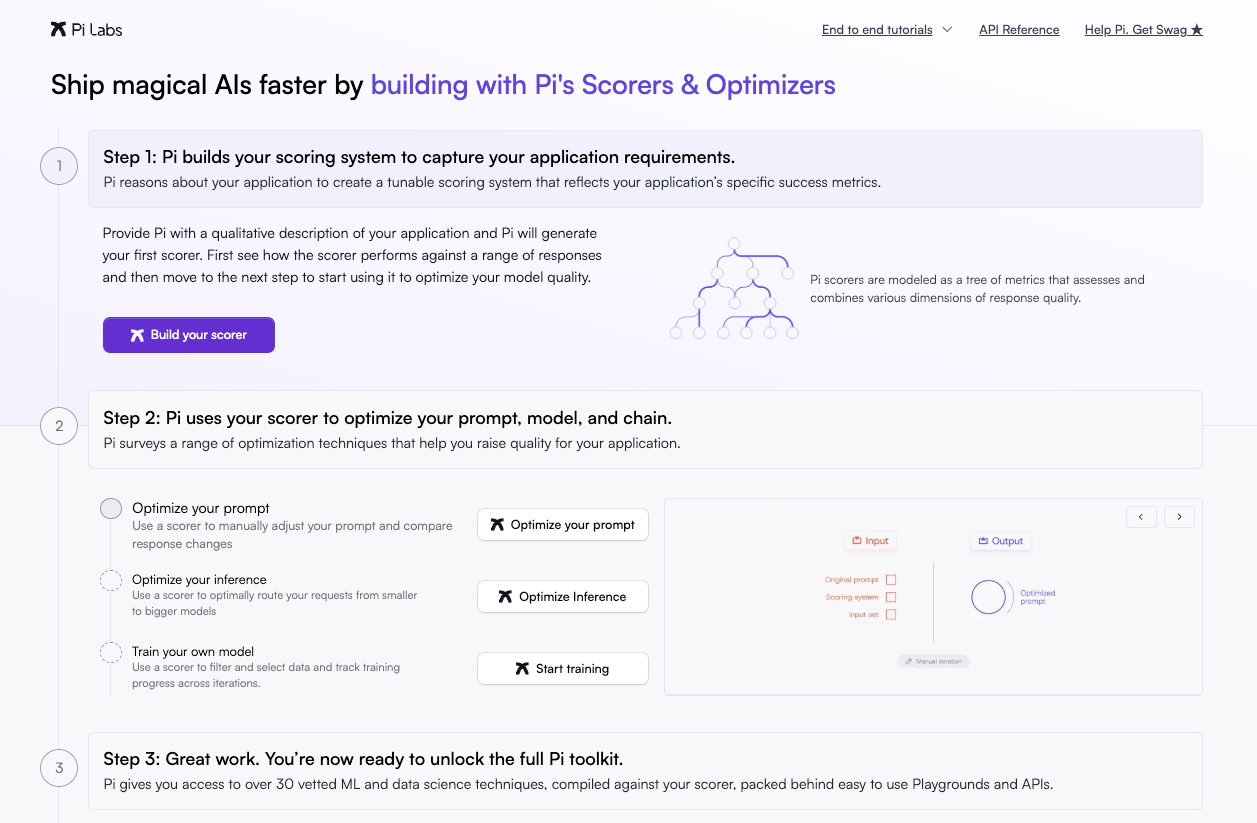Table of Contents
Overview
In the ever-evolving landscape of artificial intelligence, optimizing performance is paramount. Enter Pi, an AI toolkit developed by Pi Labs, designed to supercharge your AI applications. By integrating over 30 optimization methods and continuously aligning them with your specific goals, Pi promises to be a powerful ally in achieving peak AI performance. Let’s dive into what makes Pi tick and whether it’s the right tool for your AI endeavors.
Key Features
Pi boasts a comprehensive suite of features designed to optimize various aspects of your AI applications. Here’s a closer look:
- 30+ Optimization Techniques: Pi integrates a wide array of optimization methods, providing a versatile toolkit for addressing diverse AI challenges.
- Scoring System Creation: Define your application’s goals with a customizable scoring system, ensuring Pi aligns its efforts with your specific objectives.
- Automated Prompt Optimization: Fine-tune your prompts for maximum effectiveness, leading to more accurate and relevant AI responses.
- Search Ranking Tools: Enhance the accuracy and relevance of search results within your AI applications.
- Reinforcement Learning Integration: Seamlessly integrate reinforcement learning techniques to train and improve your AI models.
- Continuous Feedback and Adjustment: Pi constantly monitors performance and recalibrates its optimizers based on feedback, ensuring ongoing improvement.
How It Works
Pi’s functionality revolves around a goal-oriented optimization process. Users begin by defining their desired outcomes through a scoring system. This scoring system acts as a compass, guiding Pi’s suite of optimizers. These optimizers, which include techniques like prompt tuning and reinforcement learning, are then aligned with the defined goals. What sets Pi apart is its dynamic nature. As the scoring model is updated, Pi automatically recalibrates the optimizers, ensuring continuous improvement and adaptation to evolving needs. This iterative process allows for a refined and optimized AI application.
Use Cases
Pi’s versatility makes it suitable for a wide range of applications. Here are a few key use cases:
- Improving Chatbot Relevance: Enhance the accuracy and helpfulness of chatbot responses by optimizing prompts and fine-tuning the underlying AI model.
- Enhancing Search Accuracy: Improve the relevance and precision of search results within AI-powered search applications.
- Tuning Prompt Effectiveness: Optimize prompts to elicit desired responses from AI models, leading to more effective and predictable outcomes.
- Reinforcement Learning Tasks: Streamline and enhance reinforcement learning processes for training AI agents and models.
- AI Model Evaluation and Refinement: Evaluate the performance of AI models and identify areas for improvement through continuous optimization.
Pros & Cons
Like any tool, Pi has its strengths and weaknesses. Let’s weigh the advantages and disadvantages:
Advantages
- Comprehensive Optimizer Suite: Access a wide range of optimization techniques within a single platform.
- Continuous Alignment with Application Goals: Ensure that optimization efforts are always aligned with your specific objectives.
- Free Tier Available: Explore Pi’s capabilities with a free tier, allowing you to test its suitability for your needs.
- Designed by ex-Google engineers: Benefit from the expertise of experienced AI professionals.
Disadvantages
- Advanced Configuration May Require Technical Expertise: Setting up and configuring Pi’s advanced features may require a degree of technical knowledge.
- Limited Public Documentation: The availability of comprehensive public documentation may be limited, potentially hindering the learning process.
How Does It Compare?
When considering AI optimization tools, it’s essential to understand how Pi stacks up against the competition.
- PromptLayer: While PromptLayer offers prompt management capabilities, it lacks the breadth of optimizers found in Pi.
- LangChain: LangChain primarily focuses on chaining AI models together, whereas Pi is dedicated to optimizing individual model performance.
- OpenAI tools: OpenAI’s tools are largely confined to their own ecosystem and offer less customization compared to Pi’s flexible approach.
Final Thoughts
Pi presents a compelling solution for those seeking to optimize the performance of their AI applications. Its comprehensive suite of optimizers, continuous alignment with application goals, and the backing of experienced engineers make it a worthy contender in the AI toolkit landscape. While the advanced configuration may require some technical expertise and the documentation could be more extensive, the potential benefits of enhanced AI performance make Pi a tool worth considering.
https://withpi.ai/